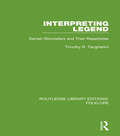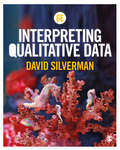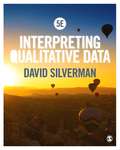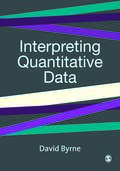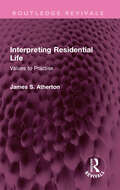- Table View
- List View
Interpreting Landscapes: Geologies, Topographies, Identities; Explorations in Landscape Phenomenology 3
by Christopher TilleyThis book takes a new approach to writing about the past. Instead of studying the prehistory of Britain from Mesolithic to Iron Age times in terms of periods or artifact classifications, Tilley examines it through the lens of their geology and landscapes, asserting the fundamental significance of the bones of the land in the process of human occupation over the long durée. Granite uplands, rolling chalk downlands, sandstone moorlands, and pebbled hilltops each create their own potentialities and symbolic resources for human settlement and require forms of social engagement. Taking his findings from years of phenomenological fieldwork experiencing different landscapes with all senses and from many angles, Tilley creates a saturated and historically imaginative account of the landscapes of southern England and the people who inhabited them. This work is also a key theoretical statement about the importance of landscapes for human settlement.
Interpreting Landscapes: Geologies, Topographies, Identities; Explorations in Landscape Phenomenology 3 (Explorations In Landscape Phenomenology; Ser.)
by Christopher TilleyThis book takes a new approach to writing about the past. Instead of studying the prehistory of Britain from Mesolithic to Iron Age times in terms of periods or artifact classifications, Tilley examines it through the lens of their geology and landscapes, asserting the fundamental significance of the bones of the land in the process of human occupation over the long durée. Granite uplands, rolling chalk downlands, sandstone moorlands, and pebbled hilltops each create their own potentialities and symbolic resources for human settlement and require forms of social engagement. Taking his findings from years of phenomenological fieldwork experiencing different landscapes with all senses and from many angles, Tilley creates a saturated and historically imaginative account of the landscapes of southern England and the people who inhabited them. This work is also a key theoretical statement about the importance of landscapes for human settlement.
Interpreting Legend: Danish Storytellers and their Repertoires (Routledge Library Editions: Folklore)
by Timothy R. TangherliniThis book, first published in 1994, sets ‘repertoire against raconteur’ in order to explore one of the world’s largest collections of folk literature. The author’s findings, and his creative and synthetic methodologies, enhance greatly our understanding of the world of the legend, and especially the basic question of ‘Who tells what to whom in the form of a legend and why?’ This work is an in-depth exploration of rural Denmark, and provides us with an excellent vantage point from which to understand legends in their cultural contexts and within the lives of their tellers.
Interpreting Legend: Danish Storytellers and their Repertoires (Routledge Library Editions: Folklore)
by Timothy R. TangherliniThis book, first published in 1994, sets ‘repertoire against raconteur’ in order to explore one of the world’s largest collections of folk literature. The author’s findings, and his creative and synthetic methodologies, enhance greatly our understanding of the world of the legend, and especially the basic question of ‘Who tells what to whom in the form of a legend and why?’ This work is an in-depth exploration of rural Denmark, and provides us with an excellent vantage point from which to understand legends in their cultural contexts and within the lives of their tellers.
Interpreting Nature: Cultural Constructions of the Environment
by I. G. SimmonsHuman society has constructed many varied notions of the environment. Scientific information about the environment is often seen as the only worthwhile knowledge. This ignores the complexities created by interaction between people and the environment. Idealist thinking argues that everything we know is based on a construct of our minds and that all is possible. Can both be correct and true? Interpreting Nature explores the position of humanity in the environment from the principle that the models we construct are imperfect and can only be provisional. Having examined the way in which the natural sciences have interrogated nature, the types of data produced and what they mean to us, this looks at the environment within philosophy and ethics, the social sciences and the arts, and analyses their role in the formation of environmental cognition.
Interpreting Nature: Cultural Constructions of the Environment
by I. G. SimmonsHuman society has constructed many varied notions of the environment. Scientific information about the environment is often seen as the only worthwhile knowledge. This ignores the complexities created by interaction between people and the environment. Idealist thinking argues that everything we know is based on a construct of our minds and that all is possible. Can both be correct and true? Interpreting Nature explores the position of humanity in the environment from the principle that the models we construct are imperfect and can only be provisional. Having examined the way in which the natural sciences have interrogated nature, the types of data produced and what they mean to us, this looks at the environment within philosophy and ethics, the social sciences and the arts, and analyses their role in the formation of environmental cognition.
Interpreting Policework: Policy and Practice in Forms of Beat Policing (Routledge Library Editions: Police and Policing)
by Roger Grimshaw Tony JeffersonIn the 1980s there existed wide and often acrimonious disagreement over the purposes and objectives of police organizations, the ways in which their activities were structured, and their relations with the wider society. Interpreting policework requires a rounded conception of policing, based on both a thorough critique of the main theoretical trends in police sociology, and close familiarity with actual patterns of policing, on the streets, in the stations, and inside the police headquarters where key policies are formulated. Originally published in 1987, the achievement of this book is that it combines rigorous theoretical analysis with a wealth of descriptive material drawn from first-hand observation of policing and decision making at all levels, and thus relates sociological theory to practice and political debate at the time. The introduction provides a careful analysis of central theoretical and political strands in police sociology, and proposes a new general conception of policework. The authors go on to provide vivid illustrations of this conception from the worlds of uniformed unit beat patrols and resident beat officers, and from the fora in which policy for operational practice is considered. A final section draws the wider lessons of these concrete analyses for sociological theory and for our understanding of past policy shifts from one form of beatwork to another, and spells out the radical implications of the study for the political debate on the future of policing. Interpreting Policework thus had relevance to students and researchers in police studies, sociology, public policy and the law at the time and will still be of historical interest today. The authors are experienced researchers, practised in investigating a wide range of criminological and social control issues.
Interpreting Policework: Policy and Practice in Forms of Beat Policing (Routledge Library Editions: Police and Policing)
by Roger Grimshaw Tony JeffersonIn the 1980s there existed wide and often acrimonious disagreement over the purposes and objectives of police organizations, the ways in which their activities were structured, and their relations with the wider society. Interpreting policework requires a rounded conception of policing, based on both a thorough critique of the main theoretical trends in police sociology, and close familiarity with actual patterns of policing, on the streets, in the stations, and inside the police headquarters where key policies are formulated. Originally published in 1987, the achievement of this book is that it combines rigorous theoretical analysis with a wealth of descriptive material drawn from first-hand observation of policing and decision making at all levels, and thus relates sociological theory to practice and political debate at the time. The introduction provides a careful analysis of central theoretical and political strands in police sociology, and proposes a new general conception of policework. The authors go on to provide vivid illustrations of this conception from the worlds of uniformed unit beat patrols and resident beat officers, and from the fora in which policy for operational practice is considered. A final section draws the wider lessons of these concrete analyses for sociological theory and for our understanding of past policy shifts from one form of beatwork to another, and spells out the radical implications of the study for the political debate on the future of policing. Interpreting Policework thus had relevance to students and researchers in police studies, sociology, public policy and the law at the time and will still be of historical interest today. The authors are experienced researchers, practised in investigating a wide range of criminological and social control issues.
Interpreting Qualitative Data
by David SilvermanThis is the perfect book for any student new to qualitative research. In this exciting and major updating of his bestselling, benchmark text, David Silverman walks the reader through the basics of gathering and analysing qualitative data. David Silverman offers beginners unrivalled hands-on guidance necessary to get the best out of a research methods course or an undergraduate research project. New to the fourth edition: - A new chapter on data analysis dealing with grounded theory, discourse analysis and narrative analysis - Further worked-through examples of different kinds of data and how to interpret them - A separate section on focus groups and interpreting focus group data - An expanded ethics chapter - More coverage of digital media and photographs as data - A companion website with additional case studies and examples, links to SAGE journals online, and links to useful websites, podcasts and Youtube videos. This fourth edition is also accompanied with its own group page on www. methodspace. com where users can give feedback and discuss research issues. Visit www. methodspace. com/group/silverman
Interpreting Qualitative Data
by David Silverman"Cutting-edge and friendly. Offers even more of what we've come to expect. Practical, yet conceptually astute. Critically attuned to new developments, such as the uses and misuses of mixed methods designs and the convenience of smart phone technology. Packaged in an approachable format that virtually welcomes the reader aboard" - Jaber F. Gubrium, University of Missouri With a wealth of examples and learning features, the book takes a practical approach to methods training and provides a strong foundation in research design for social science students. In his characteristic positive writing style, author David Silverman offers useful advice on sticking points faced by beginner researchers and helps you build your confidence. Central to this sixth edition are its online resources, including: Entertaining and inspiring videos from the author that help you unpack concepts, boost your understanding and think critically An &‘assessment corner&’, offering practical help and tailored support for typical assignments e.g. group reports and literature reviews A downloadable workbook providing a hands on way to get to grips with the necessary skills for gathering, analysing and interpreting qualitative data Approachable, clear and friendly, this book equips you with the tools to tackle key issues faced by qualitative researchers and establish good practice in your own research.
Interpreting Qualitative Data
by David Silverman"Cutting-edge and friendly. Offers even more of what we've come to expect. Practical, yet conceptually astute. Critically attuned to new developments, such as the uses and misuses of mixed methods designs and the convenience of smart phone technology. Packaged in an approachable format that virtually welcomes the reader aboard" - Jaber F. Gubrium, University of Missouri With a wealth of examples and learning features, the book takes a practical approach to methods training and provides a strong foundation in research design for social science students. In his characteristic positive writing style, author David Silverman offers useful advice on sticking points faced by beginner researchers and helps you build your confidence. Central to this sixth edition are its online resources, including: Entertaining and inspiring videos from the author that help you unpack concepts, boost your understanding and think critically An &‘assessment corner&’, offering practical help and tailored support for typical assignments e.g. group reports and literature reviews A downloadable workbook providing a hands on way to get to grips with the necessary skills for gathering, analysing and interpreting qualitative data Approachable, clear and friendly, this book equips you with the tools to tackle key issues faced by qualitative researchers and establish good practice in your own research.
Interpreting Qualitative Data
by David SilvermanIn his signature pragmatic and friendly style, David Silverman acts as your stand-in supervisor in the seventh edition of this book, taking you step-by-step through different methods for making sense of qualitative data. Whether you are interested in analysing visual images, interviews, focus groups or online data, this book provides a clear framework for using qualitative data to answer your research questions. The book provides: • A strong grounding in research design principles so you can embed best practice into your research project. • Diverse real-world examples so you can see how principles are applied in practice. • Coverage of new developments in qualitative research including working with online data. If you are new to qualitative research or conducting your first research project in the social sciences, this book gives you the practical grounding in qualitative methods you need to get started.
Interpreting Qualitative Data
by David SilvermanIn his signature pragmatic and friendly style, David Silverman acts as your stand-in supervisor in the seventh edition of this book, taking you step-by-step through different methods for making sense of qualitative data. Whether you are interested in analysing visual images, interviews, focus groups or online data, this book provides a clear framework for using qualitative data to answer your research questions. The book provides: • A strong grounding in research design principles so you can embed best practice into your research project. • Diverse real-world examples so you can see how principles are applied in practice. • Coverage of new developments in qualitative research including working with online data. If you are new to qualitative research or conducting your first research project in the social sciences, this book gives you the practical grounding in qualitative methods you need to get started.
Interpreting Qualitative Data
by David SilvermanIn his signature pragmatic and friendly style, David Silverman acts as your stand-in supervisor in the seventh edition of this book, taking you step-by-step through different methods for making sense of qualitative data. Whether you are interested in analysing visual images, interviews, focus groups or online data, this book provides a clear framework for using qualitative data to answer your research questions. The book provides: • A strong grounding in research design principles so you can embed best practice into your research project. • Diverse real-world examples so you can see how principles are applied in practice. • Coverage of new developments in qualitative research including working with online data. If you are new to qualitative research or conducting your first research project in the social sciences, this book gives you the practical grounding in qualitative methods you need to get started.
Interpreting Qualitative Data
by Professor David SilvermanIn this fifth edition of his field-defining text, David Silverman, a true guru of qualitative research, walks the reader through the basics of gathering and analyzing qualitative data. The book offers beginners unrivalled hands-on guidance to help them get the best out of a research methods course or research project. New to the fifth edition: A streamlined structure to aid navigation and guide readers smoothly through the research process. A new chapter on generalizing from case-study research which addresses the perennial issue of ‘how many cases do you need?’ New material on doing qualitative research online and the ethics of internet research. Additional sections covering organizational documents and documents of everyday life, including blogs and diaries. Many more recent case study examples drawn from a broad range of disciplines including business, education, social work and geography as well as health studies. A new and improved companion website, full of additional resources for students and lecturers. This is the perfect companion for all those new to qualitative research. Available with Perusall—an eBook that makes it easier to prepare for class Perusall is an award-winning eBook platform featuring social annotation tools that allow students and instructors to collaboratively mark up and discuss their SAGE textbook. Backed by research and supported by technological innovations developed at Harvard University, this process of learning through collaborative annotation keeps your students engaged and makes teaching easier and more effective. Learn more.
Interpreting Qualitative Data (PDF)
by David SilvermanThis is the perfect book for any student new to qualitative research. In this exciting and major updating of his bestselling, benchmark text, David Silverman walks the reader through the basics of gathering and analysing qualitative data. David Silverman offers beginners unrivalled hands-on guidance necessary to get the best out of a research methods course or an undergraduate research project. New to the fourth edition: - A new chapter on data analysis dealing with grounded theory, discourse analysis and narrative analysis - Further worked-through examples of different kinds of data and how to interpret them - A separate section on focus groups and interpreting focus group data - An expanded ethics chapter - More coverage of digital media and photographs as data - A companion website with additional case studies and examples, links to SAGE journals online, and links to useful websites, podcasts and Youtube videos. This fourth edition is also accompanied with its own group page on www. methodspace. com where users can give feedback and discuss research issues. Visit www. methodspace. com/group/silverman
Interpreting Qualitative Data (PDF)
by Professor David SilvermanIn this fifth edition of his field-defining text, David Silverman, a true guru of qualitative research, walks the reader through the basics of gathering and analyzing qualitative data. The book offers beginners unrivalled hands-on guidance to help them get the best out of a research methods course or research project. New to the fifth edition: A streamlined structure to aid navigation and guide readers smoothly through the research process. A new chapter on generalizing from case-study research which addresses the perennial issue of ‘how many cases do you need?’ New material on doing qualitative research online and the ethics of internet research. Additional sections covering organizational documents and documents of everyday life, including blogs and diaries. Many more recent case study examples drawn from a broad range of disciplines including business, education, social work and geography as well as health studies. A new and improved companion website, full of additional resources for students and lecturers. This is the perfect companion for all those new to qualitative research. Available with Perusall—an eBook that makes it easier to prepare for class Perusall is an award-winning eBook platform featuring social annotation tools that allow students and instructors to collaboratively mark up and discuss their SAGE textbook. Backed by research and supported by technological innovations developed at Harvard University, this process of learning through collaborative annotation keeps your students engaged and makes teaching easier and more effective. Learn more.
Interpreting Quantitative Data
by David ByrneHow do quantitative methods help us to acquire knowledge of the real world? What are the `do's' and `don'ts' of effective quantitative research? This refreshing and accessible book provides students with a novel and useful resource for doing quantitative research. It offers students a guide on how to: interpret the complex reality of the social world; achieve effective measurement; understand the use of official statistics; use social surveys; understand probability and quantitative reasoning; interpret measurements; apply linear modelling; understand simulation and neural nets; and integrate quantitative and qualitative modelling in the research process. Jargon-free and written with the needs of students in mind, the book will be required reading for students interested in using quantitative research methods.
Interpreting Quantitative Data (PDF)
by David ByrneHow do quantitative methods help us to acquire knowledge of the real world? What are the `do's' and `don'ts' of effective quantitative research? This refreshing and accessible book provides students with a novel and useful resource for doing quantitative research. It offers students a guide on how to: interpret the complex reality of the social world; achieve effective measurement; understand the use of official statistics; use social surveys; understand probability and quantitative reasoning; interpret measurements; apply linear modelling; understand simulation and neural nets; and integrate quantitative and qualitative modelling in the research process. Jargon-free and written with the needs of students in mind, the book will be required reading for students interested in using quantitative research methods.
Interpreting Quantitative Data with IBM SPSS Statistics
by Rachad AntoniusThe second edition of Interpreting Quantitative Data with IBM SPSS Statistics is an invaluable resource for students analysing quantitative data for the first time. The book clearly sets out a range of statistical techniques and their common applications, explaining their logic and links to the research process. It also shows how SPSS can be used as a tool to aid analysis. Key features of the second edition include: - new chapters on one-way and two-way ANOVA, the Chi-square test and linear regression. - SPSS lab sessions following each chapter which demonstrate how SPSS can be used in practice - sets of exercises and 'real-life' examples to aid teaching and learning - lists of key terms to aid revision and further reading to enhance students' understanding - an improved text design making the book easier to navigate - a companion website with answers to the labs and exercises, along with additional data sets and powerpoint slides
Interpreting Quantitative Data with IBM SPSS Statistics (PDF)
by Rachad AntoniusThe second edition of Interpreting Quantitative Data with IBM SPSS Statistics is an invaluable resource for students analysing quantitative data for the first time. The book clearly sets out a range of statistical techniques and their common applications, explaining their logic and links to the research process. It also shows how SPSS can be used as a tool to aid analysis. Key features of the second edition include: - new chapters on one-way and two-way ANOVA, the Chi-square test and linear regression. - SPSS lab sessions following each chapter which demonstrate how SPSS can be used in practice - sets of exercises and 'real-life' examples to aid teaching and learning - lists of key terms to aid revision and further reading to enhance students' understanding - an improved text design making the book easier to navigate - a companion website with answers to the labs and exercises, along with additional data sets and powerpoint slides
Interpreting Quantitative Data with SPSS
by Rachad AntoniusBy focusing on the use of SPSS as a tool to doing social research - and not the `be all and end all' to the research problem - this book will be an invaluable resource for students learning about descriptive statistics and some topics in inferential statistics for the first time. It will provide students with a range of tools to help interpret data in the context of their research and to be appropriately selective in the choice of methods for handling data. Through its many features, concise content and overall clarity of writing this should be popular for students in a range of disciplines. It clearly explains the range of statistical techniques and their common applications and offers a useful evaluation of the context in which they should be applied.Key features of the book include:- 14 SPSS lab sessions which demonstrate how SPSS can be used in the practical research context- Sets of exercises and `real-life' examples in each chapter to aid teaching and learning- Offers a step-by-step guide to help students successfully integrate these examples in a descriptive written report- Lists of key terms and further reading to enhance student's understanding of the subject- User-friendly and accessible penetration throughoutSuggested exercises and answers will be available from the author's own webpage on publication. Please visit the link below. http://www.champlaincollege.qc.ca/antonius>Suggested Exercises and Answers
Interpreting Residential Life: Values to Practise (Routledge Revivals)
by James S. AthertonFirst published in 1989 Interpreting Residential Life raises questions like – a) what makes residential establishments tick, b) what is going on beneath the surface of the daily routine, c) why is change so difficult to create and even more difficult to sustain, and d) how can residential social workers evaluate their work? James Atherton provides a set of tools to enable residential workers to answer these questions in their own establishments. Simply and directly, he provides a framework which shows how policy and practice relate to each other and reinforce or hinder each other, in crises as well as in routines. He examines the whole residential establishment as a social system, concentrating on daily life within it, and demonstrating how values are implicit in all aspects of practice. He draws on the experiences of residential staff at all levels to uncover the working myths and offers ways of understanding how establishments function and indicates the pathways to change. This is an essential read for students of social work and sociology.
Interpreting Residential Life: Values to Practise (Routledge Revivals)
by James S. AthertonFirst published in 1989 Interpreting Residential Life raises questions like – a) what makes residential establishments tick, b) what is going on beneath the surface of the daily routine, c) why is change so difficult to create and even more difficult to sustain, and d) how can residential social workers evaluate their work? James Atherton provides a set of tools to enable residential workers to answer these questions in their own establishments. Simply and directly, he provides a framework which shows how policy and practice relate to each other and reinforce or hinder each other, in crises as well as in routines. He examines the whole residential establishment as a social system, concentrating on daily life within it, and demonstrating how values are implicit in all aspects of practice. He draws on the experiences of residential staff at all levels to uncover the working myths and offers ways of understanding how establishments function and indicates the pathways to change. This is an essential read for students of social work and sociology.
Interpreting Social and Behavioral Research: A Guide and Workbook Based on Excerpts from Journals
by Linda E DorstenFirst published in 1996. This book is designed to help students acquire basic skills needed to comprehend social and behavioural science research reports. These skills are needed to understand research results that we confront in our everyday lives in magazines, newspapers, on television, and elsewhere. It includes a guide and a workbook.

